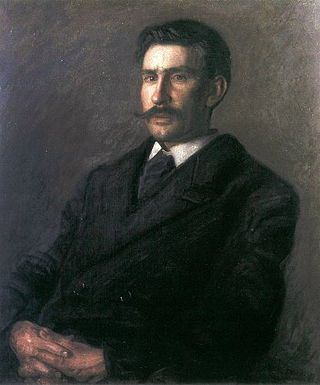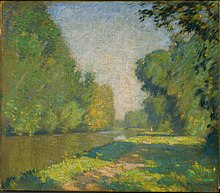
New Hope is a borough in Bucks County, Pennsylvania, United States. The population was 2,612 at the 2020 census. New Hope is located approximately 30 mi (48 km) north of Philadelphia, and lies on the west bank of the Delaware River at its confluence with Aquetong Creek. New Hope and neighboring Solebury and Upper Makefield townships are part of the Philadelphia metropolitan area. The two-lane New Hope–Lambertville Bridge carries automobile and foot traffic across the Delaware to Lambertville, New Jersey, on the east bank. New Hope's primary industry is tourism.

American Impressionism was a style of painting related to European Impressionism and practiced by American artists in the United States from the mid-nineteenth century through the beginning of the twentieth. The style is characterized by loose brushwork and vivid colors with a wide array of subject matters but focusing on landscapes and upper-class domestic life.

Mary Elizabeth Price, also known as M. Elizabeth Price, was an American Impressionist painter. She was an early member of the Philadelphia Ten, organizing several of the group's exhibitions. She steadily exhibited her works with the Pennsylvania Academy of the Fine Arts, the National Academy of Design, and other organizations over the course of her career. She was one of the several family members who entered the field of art as artists, dealers, or framemakers.

William Langson Lathrop was an American Impressionist landscape painter and founder of the art colony in New Hope, Pennsylvania, where he was an influential founder of Pennsylvania Impressionism.

Edward Willis Redfield was an American Impressionist landscape painter and member of the art colony at New Hope, Pennsylvania. He is best known today for his impressionist scenes of the New Hope area, often depicting the snow-covered countryside. He also spent his summers on Boothbay Harbor, Maine, where he interpreted the local coastline. He frequently painted Maine's Monhegan Island.

Daniel Garber was an American Impressionist landscape painter and member of the art colony at New Hope, Pennsylvania. He is best known today for his large impressionist scenes of the New Hope area, in which he often depicted the Delaware River. He also painted figurative interior works and excelled at etching. In addition to his painting career, Garber taught art at the Pennsylvania Academy of the Fine Arts for over forty years.

John Emil Berninger was an American landscape painter and Pennsylvania impressionist. He lived and painted in Allentown, Pennsylvania.

Karl Henry Buesgen, Sr. was an American landscape painter and Pennsylvania impressionist typically associated with the Baum Circle, a group of artists either taught by, associated with, or directly influenced by Pennsylvania impressionist painter Walter Emerson Baum.

Walter Emerson Baum was an American visual artist and educator, active in the Bucks and Lehigh County areas of Pennsylvania. In addition to being a prolific painter, Baum was also responsible for the founding of the Baum School of Art, and the Allentown Art Museum.

The Michener Art Museum is a private, non-profit museum that is located in Doylestown, Bucks County, Pennsylvania. Founded in 1988, it was named for the Pulitzer Prize–winning writer James A. Michener, a Doylestown resident.

The Reading Public Museum is a museum in Reading, Pennsylvania, located in the 18th Ward, along the Wyomissing Creek. The museum's permanent collection mainly focuses on art, science, and civilization and contains over 280,000 objects. It also has a planetarium and a 25-acre (100,000 m2) arboretum.

John Fulton "Jack" Folinsbee was an American landscape, marine and portrait painter, and a member of the art colony at New Hope, Pennsylvania. He is best known today for his impressionist scenes of New Hope and Lambertville, New Jersey, particularly the factories, quarries, and canals along the Delaware River.

Fern Isabel Coppedge was an American impressionist painter.

Roy Cleveland Nuse (1885–1975) was an American painter, curator, and a teacher, associated with Pennsylvania Impressionism. He taught at the Pennsylvania Academy of the Fine Arts (PAFA) in Philadelphia, from 1925 to 1954.

William Newport Goodell (1908–1999) was an American artist, craftsman, and educator. He was born August 16, 1908, in Germantown, Philadelphia and briefly attended the Pennsylvania Academy of the Fine Arts (PAFA), including its country school in Chester Springs, studying under Pennsylvania impressionist Daniel Garber and noted academician Joseph Thurman Pearson, Jr., before opening his own studio on Germantown Avenue in 1929.

Charles Rosen was an American painter who lived for many years in Woodstock, New York. In the 1910s he was acclaimed for his Impressionist winter landscapes. He became dissatisfied with this style and around 1920 he changed to a radically different cubist-realist (Precisionism) style. He became recognized as one of the leaders of the Woodstock artists colony.

Rae Sloan Bredin was an American painter. He was a member of the New Hope, Pennsylvania school of impressionists. He is known for his peaceful spring and summer landscapes with relaxed groups of women and children.

Morgan Colt was an American metalworker, furniture craftsman, impressionist painter, and architect. He helped found the New Hope, Bucks County, Pennsylvania colony of painters—the leading landscape school in the United States during the early 20th–century—but was better known as a craftsman than a painter, specializing in hand–wrought iron garden furniture and fire screens. Many of his paintings were accidentally destroyed after his death.

Robert Carpenter Spencer was an American painter who received extensive recognition in his day. He was one of the Pennsylvania impressionists, but is better known for his paintings of the mills and working people of the Delaware River region than for landscapes. His work is held in numerous public collections.

Walter Elmer Schofield was an American Impressionist landscape and marine painter. Although he never lived in New Hope or Bucks County, Schofield is regarded as one of the Pennsylvania Impressionists.




















